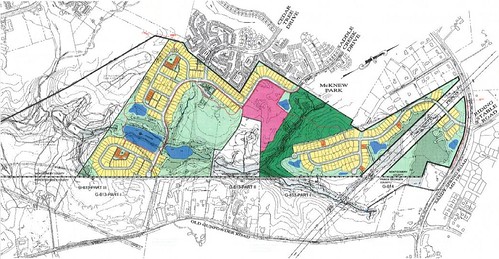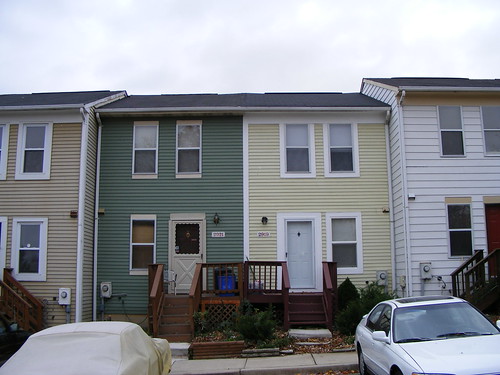 Fairland Park Community proposed site plan. The orange areas are where MPDUs are proposed to go.
Fairland Park Community proposed site plan. The orange areas are where MPDUs are proposed to go.Citing a perceived glut of low-cost homes nearby, Planning Department staff wants to reduce the amount of affordable housing in a planned Burtonsville development going before the Board this afternoon. The 493-home Fairland Park Community on Route 198 straddling the Montgomery/Prince George’s County line has been in planning limbo for several years. Part of the long-awaited Konterra “mini-city,” the 314-acre site is one of the area’s last vacant tracts of developable land. Questions remain about how it’ll look now that plans to incorporate the public Gunpowder Golf Course have been shelved.
The Fairland Master Plan Citizens Advisory Committee, which guided that document’s creation eleven years ago, seeks a waiver for a requirement that twenty percent of the 365 homes on the Montgomery side be Moderately Priced Dwelling Units. By law, seventy-three units are required; they and developer Artery Homes propose building forty-eight townhomes and duplexes instead. The committee says adding a “token amount of additional townhouses” would “neither result in community diversity or distinctiveness,” according to the staff report.
Fairland resident Stuart Rochester, who sat on the committee, says building the required amount of MPDUs would only exacerbate the “demographic and housing imbalances” in East County. The Master Plan’s goal, he writes in a letter to the Board (see staff report: warning! PDF file.), was to “create a distinctive community of ‘move-up’ housing to encourage residents to remain in the area,” which has “taken a disproportionate number . . . of townhouses and apartments.”
He says that the waiver has been “supported without argument” by the County Council, but doesn’t say if there’s been any opposition or even awareness of the project. With the District 4 County Council seat vacant for six of the past fifteen months, Burtonsville has been without a representative to keep track of or express any opinion on the waiver.
so much more AFTER THE JUMP . . .
 The duplexes in Fairland Park may be disguised to look like single-family homes, like these built by Pulte Homes in the Fallsgrove neighborhood of Rockville. (Image courtesy of the Olney Coalition.)
The duplexes in Fairland Park may be disguised to look like single-family homes, like these built by Pulte Homes in the Fallsgrove neighborhood of Rockville. (Image courtesy of the Olney Coalition.)In the letter, Rochester fails to make the distinction between attached housing and affordable housing, suggesting that townhomes and apartments attract lower-income people by default. “Townhouses are being converted to rental units in the challenged neighborhoods east of US 29,” he writes, “and elementary school transiency rates remain among the highest in the County.”
This assertion completely ignores the possibility that people may live in townhomes and apartments by choice, and not solely because it’s all they can afford. There are many market segments – working professionals, or young families – for whom attached housing is attractive. “Higher-end” townhomes with features like gourmet kitchens and two-car garages have been very popular in East County over the past several years as seen in recently-built subdivisions like ParkView on Greencastle Road, Whitehall Square in White Oak, and the unconventional Albany Grove in Briggs Chaney.
Lisa Schwartz, planner from the county Department of Housing and Community Affairs, says if you want a balanced community, don’t set aside all the townhouses for poor people. She e-mailed the Planning Department requesting that the developer consider including some market-rate townhouses in the project. “It is DHCA’s position that such a plan would be more in keeping with the Fairland Master Plan’s general recommendation to ‘encourage dispersal of MPDUs in new developments,’” she writes.
The plan already takes that progressive approach to site planning, mixing single-family homes and townhomes throughout the property. Many homes have alleys and rear garages, and the project’s streets even connect to those in surrounding subdivisions, making it potentially very pedestrian-friendly. (Never mind that there will be nothing to walk to here, save for a proposed elementary school on land provided by the developer.) This is a far cry from older East County subdivisions like Tanglewood or the adjacent Saddle Creek, where townhouses and single-family homes are put into separate “pods,” informally segregating people by what they make and how they’d like to live.
 The Fairland Master Plan Citizens Advisory Committee says more affordable housing will give East County a "cookie-cutter" appearance.
The Fairland Master Plan Citizens Advisory Committee says more affordable housing will give East County a "cookie-cutter" appearance.Once again, the Fairland Park Community controversy points to the wounds left open by development patterns twenty years ago that directed housing to East County without accompanying jobs and improvements to infrastructure, namely rapid transit. Removing the golf course from the project – a sore spot because the original course was a public amenity to begin with – only strengthens the fear that Montgomery County is “playing favorites” with the more affluent communities on the west side.
“It would be unimaginable that if the golf course had been removed from the Avenel plan, the adjacent Potomac homeowners and the surrounding community would not have been a full participant in discussing an alternative concept,” Rochester writes, referring to the sought-after golf course neighborhood. “The Burtonsville community deserves as much.”
Burtonsville does deserve a say in the process, but encouraging the use of a loophole that makes an already-expensive housing market even more inaccessible is disappointing use of their voice. Whether or not homes are built with government subsidies, prices go up for everyone when the supply of new units is decreased. Yes, East County needs jobs – and between the 8,000 arriving at the FDA campus and 3,000 more at the new Washington Adventist Hospital, we’re getting our share. People have to live somewhere, and we might as well embrace them with open arms.

5 comments:
Wow, you can look at this two different ways:
1. "Stop at nothing to make sure that poor people are forced out of District 4 by lack of MPDU."
2. "Stop at nothing to make sure that District 4 concentrates poverty and 'minorities' remain the majority."
Or maybe they could get a special waiver so long as they write it into the contract that MPDU can be waived so long as the up-scale dwellings built instead of MPDU are available only to "minorities".
Some people would call that "progressive".
I'd call it creative problem solving that only violates a couple of dozen landmark Federal anti-discrimination laws, but hey, it's not like the County isn't utterly determined to ignore Federal law already...
why dont they rebuild some of the decaying suburbs around silver spring/tacoma park instead of making more sprawl
In response to Akil, I first have to question the premise. I live near downtown Silver Spring, and I'm not aware of any "decaying suburbs." What I do see is an amazing amount of remodeling and construction of additions on houses even in the midst of the worst housing market in years.
Second, it is more profitable for developers to build new houses on large tracts, so that is what they do. It would be virtually impossible to assemble equally large tracts composed of existing individually owned homes so they could be demolished and replaced with new construction.
Then there is the sprawl notion. Just what is sprawl? Today's inner suburb smart growth areas -- neighborhoods where the infrastructure and housing already exist -- were sprawl in the 1920s and 1930s when they were built. Who is to say that what we consider sprawl today will be seen as such in the future?
yes, your right I should have said neighborhoods toward langley park and parts of wheaton that are showing their age, but are you suggesting we just keep building further and further out on undeveloped land until all of montgomery county is one huge suburbia like north jersey
To keep our facts straight about the proposed Fairland Community development amendment, the Planning Board is not considering anything less than the required 12.5 percent of moderately priced dwelling units. The waiver mentioned is unrelated to the MPDU calculation. The applicant is required to provide 12.5 percent of the total 365 units, which is 46 units.
Post a Comment